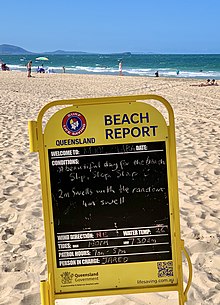Slip-Slop-Slap


Slip-Slop-Slap was a sun protection campaign prominent in Australia and New Zealand during the 1980s. Launched by Cancer Council Victoria in 1981 and funded by public donations,[1] the Slip! Slop! Slap! campaign featured an anthropomorphic seagull mascot named Sid the Seagull, who would sing and dance to the phrase to encourage people to reduce sun exposure and protect themselves against an increased risk of skin cancer.[2] The campaign would be come quite successful over its original run.
It was briefly revived in 2010 to celebrate 30 years of the "Slip, Slop, Slap" campaign, with Sid the Seagull singing to a revised jingle "Slip, Slop, Slap, Seek and Slide" this phrase would replace the old campaign. The revived campaign was successful but not as much as the original.
An alternate version known as "Slip, Slop, Slap and Wrap" was used in New Zealand,[3] where the mascot was a tiger prawn named Tiger, voiced by Ants from What Now. Some Canadian cities have also started their own Slip-Slop-Slap campaigns. In Britain, it was used on the "BBC Breakfast Programme" 27 June 2011 with Bill Turnbull and Sian Williams.
Effect on cancer rates[]
Since this campaign was introduced along with advertisements and a jingle, the incidence of the two most common forms of skin cancer (basal-cell carcinoma and squamous cell carcinoma) in Australia has decreased. However, the incidence of melanoma, the most lethal form of skin cancer, has increased.[4] An epidemiological study published in 2002 concluded that skin cancer increases could not be associated with the use of sun creams, and recommended continued use of the current campaigns as a means to reduce melanoma risk.[5]
The experience of more than 25 years of skin cancer prevention in Australia shows broad-based multifaceted public education programs can improve a population's sun protective behaviors and reducing sunburn, a short-term marker of skin cancer risk.[6] Furthermore, declining skin cancer incidence in younger cohorts and economic assessment show skin cancer prevention programs are an eminently worthwhile investment.[6]
See also[]
- Health effects of sun exposure
- Skin cancer in Australia
References[]
- ^ "Past TV campaigns". SunSmart.
- ^ Stephen Lunn (7 January 2008). "Sun worshippers need a slap of reality". The Australian.
- ^ "Outdoor workers shun sun protection". 3 News NZ. April 23, 2013.
- ^ Garland C, Garland F, Gorham E (1992). "Could sunscreens increase melanoma risk?". Am J Public Health. 82 (4): 614–5. doi:10.2105/AJPH.82.4.614. PMC 1694089. PMID 1546792.
- ^ Bastuji-Garin, S; Diepgen, TL (2002). "Cutaneous malignant melanoma, sun exposure, and sunscreen use: epidemiological evidence". British Journal of Dermatology. 146 (6): 24–30. doi:10.1046/j.1365-2133.146.s61.9.x. Archived from the original on 2012-10-21.
- ^ a b Hill DJ, Dobbinson SJ, Makin J. Interventions to lower ultraviolet radiation exposure: Education, legislation and public policy. ASCO 2009 Education Book 2009: 526-531.
- Advertising campaigns
- Australian advertising slogans
- New Zealand advertising slogans
- 1981 neologisms
- Australian slang
- Sun tanning
- Healthcare in Australia
- Health campaigns